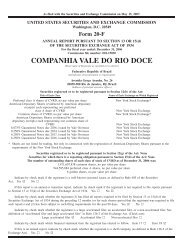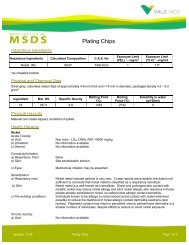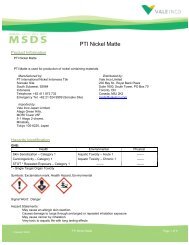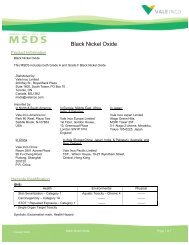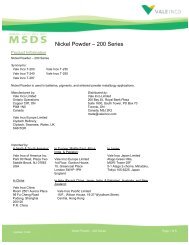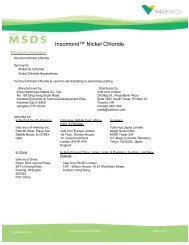Create successful ePaper yourself
Turn your PDF publications into a flip-book with our unique Google optimized e-Paper software.
(ACCORDING TO EC-REGULATION 1907/2006 (REACH) & 1272/2008 (CLP))<br />
Section 1. Identification of the Substance and Company<br />
1.1 Product Identification:<br />
Product Name: <strong>Tonimet</strong> Nickel<br />
Synonyms:<br />
<strong>Tonimet</strong> ® granule, <strong>Tonimet</strong> ® Briquette, <strong>Tonimet</strong> ® <strong>com</strong>pact<br />
Chemical Family: Metal<br />
EC No: 231-111-4<br />
CAS No: 7440-02-0<br />
REACH Registration number: see Section 3<br />
1.2 Uses<br />
Identified Uses:<br />
• Stainless, special steels and special alloys manufacturing<br />
• Integrated steel and iron<br />
• EAF carbon steel manufacturing<br />
• Powder metallurgy<br />
• Use of brazing alloys<br />
Uses Advised Against:<br />
• Use of nickel in articles intended for direct and prolonged contact with the skin where the release<br />
of nickel exceed the limit set out in Directives 94/27/EC and 2004/6/EC and REACH regulation<br />
1907/2009 (Annex XVII).<br />
• Use of nickel in nickel-containing food contact materials for which migration into foodstuff would<br />
exceed more than 0.1 mg/kg of nickel in accordance with the Council of Europe Guidelines on<br />
metals and alloys used as food contact materials (2002)<br />
• Use of nickel in immersion-type kettles which would release more than 0.05 mg/l of nickel into the<br />
water in accordance with the Council of Europe Guidelines on metals and alloys used as food<br />
contact materials (2002)<br />
• Use of nickel in <strong>com</strong>mercially available “do-it-yourself” home electroplating kits.<br />
Exposure Scenarios: See Annex 1<br />
1.3 Company Identification<br />
<strong>Vale</strong> Europe Limited<br />
Clydach, Swansea<br />
SA6 5QR<br />
msds@vale.<strong>com</strong><br />
REACH@vale.<strong>com</strong><br />
Telephone Number: +44 (0) 1792 842501<br />
<strong>Tonimet</strong> ®<br />
For Fire, Spill, or chemical emergency call CHEMTREC: +44 (0) 870-8200418<br />
Created: 29 - October – 2012 <strong>Tonimet</strong>® Page: 1 of 16<br />
V1
Section 2. Hazards Identification<br />
2.1 Classification of the Substance:<br />
2.1.1 Classification according Regulation (EC) No. 1272/2008<br />
Skin Sensitization – Category 1;<br />
Carcinogenicity – Category 1A;<br />
Specific Target Organ Toxicity, Repeated exposure – Category 1<br />
Hazard Pictograms:<br />
Signal Word:<br />
Hazard Statements:<br />
Precautionary Statements:<br />
GHS07 - Exclamation mark, GHS08 - Health Hazard<br />
Danger<br />
H317 - May cause an allergic skin reaction.<br />
H350 – May cause cancer by inhalation<br />
H372 - Causes damage to lungs through prolonged or repeated inhalation<br />
exposure<br />
P201, P202, P260, P261, P272, P280, P281, P264, P270, P302+P352, P308+P313,<br />
P333+P313, P314, P321, P363, P405, P501<br />
2.1.2. Classification according to Directive 67/548/EEC<br />
Carc. Cat. 1; R49<br />
T, R48/23<br />
R43<br />
2.2: Label elements<br />
Labeling according to Regulation (EC) No 1272/2008<br />
Product identifier: <strong>Tonimet</strong><br />
CAS #: 7440-02-0<br />
Symbols: GHS07 - Exclamation mark, GHS08 - Health Hazard<br />
Signal Word: Danger<br />
Hazard Statements: H317, H350, H372<br />
Precautionary Statements P202, P261, P281, P302+352, P501<br />
(NOTE: number of P-statements has been reduced as per CLP regulation, the full list can be found in Section 15).<br />
For full text of R-Statements and Precautionary, statements see section 15.<br />
Created: 29 - October – 2012 <strong>Tonimet</strong>® Page: 2 of 16<br />
V1
2.3: Other Hazards<br />
The PBT and vPvB criteria of Annex XIII of the REACH regulation does not apply to inorganic substances, such<br />
as nickel metal<br />
Section 3. Composition<br />
Substance<br />
<strong>Tonimet</strong> Granule:<br />
Mixture (SVHC)<br />
Composition<br />
Nickel Metal 87%<br />
Nickel Oxide 10%<br />
Hazardous<br />
EINECS/<br />
Typical Composition<br />
C.A.S.<br />
Ingredients<br />
EC Label No.<br />
Nickel 95% 7440-02-0 231-111-4<br />
Cobalt 1.3% 7440-48-4 231-158-0<br />
Iron 0.6% 7439-89-6 231-096-4<br />
Copper 0.1% 7440-50-8 231-159-6<br />
Sulphur 0.003% 7704-34-9 231-722-6<br />
<strong>Tonimet</strong> Briquette:<br />
Composition<br />
Nickel Metal 85%<br />
Nickel Oxide 10%<br />
Hazardous<br />
Ingredients<br />
Typical Composition<br />
C.A.S.<br />
EINECS/<br />
EC Label No.<br />
Nickel 93% 7440-02-0 231-111-4<br />
Cobalt 1.3% 7440-48-4 231-158-0<br />
Silica 1.2% 7631-86-9 231-545-4<br />
Iron 0.6% 7439-89-6 231-096-4<br />
Sodium<br />
Oxide<br />
0.5% 1313-59-3 215-208-9<br />
Copper 0.1% 7440-50-8 231-159-6<br />
Sulphur 0.003% 7704-34-9 231-722-6<br />
Created: 29 - October – 2012 <strong>Tonimet</strong>® Page: 3 of 16<br />
V1
<strong>Tonimet</strong> Compact:<br />
Composition<br />
Nickel Metal 96%<br />
Nickel Oxide 1.5%<br />
Hazardous<br />
C.A.S.<br />
EINECS/<br />
Typical Composition<br />
Ingredients<br />
EC Label No.<br />
Nickel 97% 7440-02-0 231-111-4<br />
Cobalt 1.3% 7440-48-4 231-158-0<br />
Iron 0.6% 7439-89-6 231-096-4<br />
Copper 0.1% 7440-50-8 231-159-6<br />
Sulphur 0.003% 7704-34-9 231-722-6<br />
REACH Registration #’s:<br />
01-2119438727-29-xxxx – LR; <strong>Vale</strong> Europe Limited<br />
01-2119438727-29-xxxx – OR; <strong>Vale</strong> Japan Limited<br />
Section 4. First Aid Measures<br />
Ingestion:<br />
No specific first aid required.<br />
Inhalation:<br />
Skin:<br />
Eyes:<br />
Most important symptoms<br />
and affects, both acute and<br />
delayed<br />
Indication of immediate<br />
medical attention and<br />
special treatment needed<br />
No specific first aid required.<br />
Remove contaminated clothing, and wash affected areas thoroughly with water.<br />
If skin irritation or rash occurs: Get medical advice/attention. Show label if<br />
possible.<br />
Irrigate eyeball thoroughly with water for at least 10 minutes. If dis<strong>com</strong>fort<br />
persists seek medical attention.<br />
Skin contact: Rash<br />
Eye contact: Redness<br />
No special requirements<br />
Section 5. Fire Fighting Measures<br />
Suitable<br />
extinguishing<br />
media:<br />
Any, type to be selected according to materials stored in the immediate<br />
neighborhood.<br />
Special risks:<br />
Non-flammable. May oxidize to Nickel Oxide if exposed to high temperatures<br />
within a fire. Keep containers cool with water spray.<br />
Created: 29 - October – 2012 <strong>Tonimet</strong>® Page: 4 of 16<br />
V1
Special protective equipment<br />
for fire fighting:<br />
None needed. Wear protective equipment if required for other materials within<br />
the immediate vicinity.<br />
Section 6. Accidental Release Measures<br />
Person related precautionary<br />
measures:<br />
Avoid generation of dusty atmospheres. Do not inhale dusts. Contaminated<br />
work clothing should not be allowed out of the workplace. Use personal<br />
protective equipment as required. Wash hands, and face thoroughly after<br />
handling.<br />
Environmental Protection<br />
measures:<br />
Procedures for<br />
cleaning/absorption:<br />
No specific measures needed.<br />
Pick up and replace in original container. Nickel-containing material is<br />
normally collected to recover nickel values.<br />
Section 7. Handling and Storage<br />
7.1 Precautions for Safe<br />
Handling:<br />
Prevent the generation of inhalable dusts e.g. by the use of suitable ventilation.<br />
Do not inhale dust. Wear appropriate nationally approved respirators if handling<br />
is likely to cause the concentration limits of airborne nickel to exceed the locally<br />
prescribed exposure limits. Wear suitable protective clothing and gloves.<br />
Contaminated work clothing should not be allowed out of the workplace<br />
7.2 Conditions for Safe<br />
Storage:<br />
Keep in the container supplied, and keep container closed when not in use.<br />
Local regulations should be followed regarding the storage of this product.<br />
Section 8. Exposure Controls / Personal Protection<br />
8.1.1 Exposure Limits:<br />
Nickel Metal (Ni) – CAS 7440-02-0<br />
Exposure Limit (mg/m 3 )<br />
Year<br />
ACGIH TLV-TWA (1) 1.5 * 2008<br />
UK WEL (2) 0.5 2006<br />
Japan 1 2012<br />
Korea 1 2006<br />
China 1 2007<br />
* - as Ni in inhalable fraction<br />
Created: 29 - October – 2012 <strong>Tonimet</strong>® Page: 5 of 16<br />
V1
Nickel Oxide (NiO) – CAS 1313-99-1<br />
Exposure Limit (mg/m 3 )<br />
Year<br />
ACGIH TLV-TWA (1) 0.2 * ‡ as Ni 2008<br />
UK WEL (2) 0.5 as Ni 2006<br />
French VLE 1 as Ni 2008<br />
Japan 0.1 as Ni 2012<br />
Korea 0.1 as Ni 2006<br />
China 1 as Ni 2007<br />
* Inhalable fraction<br />
‡ Insoluble inorganic fraction<br />
Cobalt (Co) – CAS 7440-48-4<br />
Exposure Limit (mg/m 3 )<br />
Year<br />
ACGIH TLV-TWA (1) 0.02 2008<br />
UK WEL (2) 0.1 2006<br />
Japan 0.05 1992<br />
Korea 2006<br />
China 0.05 2007<br />
8.1.2 Environmental Limits:<br />
PNEC’s<br />
Compartment Unit PNEC<br />
Freshwater<br />
μg Ni/L<br />
(bioavailable)<br />
3.55<br />
Marine μg Ni/L 8.6<br />
Terrestrial mg Ni/kg 29.9<br />
DNEL’s<br />
Unit<br />
DNEL<br />
Dermal<br />
Acute systemic mgNi/kg/day -<br />
Acute local mgNi/cm 2 /day -<br />
Long-term systemic mgNi/kg/day -<br />
Long-term local mgNi/cm 2 /day 0.015<br />
Inhalation<br />
Acute systemic mgNi/m 3 816<br />
Acute local mgNi/m 3 1.6 1<br />
Long-term systemic mgNi/m 3 0.05 2<br />
Long-term local mgNi/m 3 0.05 2<br />
Created: 29 - October – 2012 <strong>Tonimet</strong>® Page: 6 of 16<br />
V1
1 Based on MMAD of 1.5 um, increases with increasing MMAD (estimated as ≥6.4 mg Ni/m 3 for exposures to<br />
particles with a MMAD of ≥30 μm.<br />
2 When exposure are solely to metallic and oxidic nickel dusts (without exposure to soluble nickel or sulfidic<br />
nickel) and the mean particle size of the aerosol is greater than 10 μ m aerodynamic diameter (≤10% of<br />
aerosol mass in respirable fraction), inhalable exposure levels up to 0.2 mg Ni/m 3 could be reasonably<br />
assumed to be safe.<br />
8.2.1 Occupational exposure controls:<br />
As supplied, this product does not pose a health hazard by inhalation. Mechanical extraction ventilation may<br />
be required if user operations change it to other physical or chemical forms, whether as end products,<br />
intermediates or fugitive emissions, which are inhalable. Maintain airborne nickel levels as low as possible.<br />
Avoid repeated skin contact.<br />
PPE<br />
Respiratory protection:<br />
Eye protection:<br />
Hand & Skin Protection:<br />
If required, use an approved respirator with particulate filters.<br />
None<br />
Wear suitable protective clothing and gloves, which should be selected<br />
specifically for the working place, depending on concentration and quantity of<br />
the hazardous material (overalls and leather/rubber gloves). Wash skin<br />
thoroughly after handling and before eating, drinking or smoking. Change<br />
contaminated clothing frequently. Launder clothing and gloves as needed. Use<br />
of skin-protective barrier cream advised.<br />
Section 9. Physical And Chemical Properties<br />
Physical state at 20°C and 101.3 kPa<br />
solid<br />
Melting / freezing point 1455°C<br />
Boiling point 2730°C<br />
Relative density 8.9 g/cm 3 at 25°C<br />
Vapour pressure<br />
1 mm Hg at 1810°C.<br />
Surface tension<br />
Not applicable<br />
Water solubility<br />
Not applicable<br />
Partition coefficient n-octanol/water (log Not applicable<br />
Flash point<br />
Not applicable<br />
Flammability<br />
Non-flammable<br />
Explosive properties<br />
Non-explosive<br />
Self-ignition temperature<br />
Autoflammability is not applicable to massive nickel metal.<br />
Oxidising properties<br />
Non-oxidising<br />
Granulometry Granule: 0.2 – 0.8mm<br />
Briquette: 20mm x 30mm x 15mm<br />
T97 Granule: 0.2 – 0.8mm<br />
T97 Compact: 25mm diameter<br />
15 mm thickness<br />
Created: 29 - October – 2012 <strong>Tonimet</strong>® Page: 7 of 16<br />
V1
Stability in organic solvents and identity of<br />
relevant degradation products<br />
Dissociation constant<br />
Viscosity<br />
Magnetic Properties<br />
Not applicable<br />
Not applicable<br />
Not applicable<br />
Ferromagnetic<br />
Section 10. Stability And Reactivity<br />
10.1 Reactivity Stable under normal conditions.<br />
10.2 Chemical stability Stable under normal conditions.<br />
10.3 Possibility of hazardous Stable under normal conditions.<br />
reactions<br />
10.4 Conditions to avoid This product can react vigorously with acids to liberate hydrogen, which can<br />
form explosive mixtures with air. Under special conditions nickel can react<br />
with carbon monoxide in reducing atmospheres to form nickel carbonyl,<br />
Ni(CO) 4, a toxic gas. Metal powders when heated in reducing atmospheres<br />
may be<strong>com</strong>e pyrophoric.<br />
10.5 In<strong>com</strong>patible materials Acids, Strong oxidising agents.<br />
10.6 Hazardous<br />
De<strong>com</strong>position<br />
Product(s)<br />
Nickel carbonyl gas<br />
Section 11. Toxicological Information<br />
As a mixture the toxicological properties of this product are unknown. The toxicology of the reported<br />
ingredients are summarized below.<br />
Nickel<br />
Acute Toxicity:<br />
a) Oral: Non toxic - LD 50 ORAL RAT >9000 mg/kg<br />
b) Inhalation: No information available<br />
c) Dermal: No information available.<br />
Corrosivity/Irritation:<br />
a) Respiratory Tract: None<br />
b) Skin: See sensitization section.<br />
c) Eyes: Mechanical irritation may be expected.<br />
Sensitization:<br />
Created: 29 - October – 2012 <strong>Tonimet</strong>® Page: 8 of 16<br />
V1
a) Respiratory tract: Nickel metal induced asthma is very rare. 3 case reports are available; the data<br />
is not sufficient to conclude that nickel metal is classified as a respiratory<br />
sensitizer.<br />
b) Skin: Nickel metal is a well-known skin sensitizer. Direct and prolonged skin contact<br />
with metallic nickel may induce nickel allergy and elicit nickel allergic skin<br />
reactions in those people already sensitized to nickel, so called nickel allergic<br />
contact dermatitis.<br />
c) Pre-existing conditions: Individuals known to be allergic to nickel should avoid contact with nickel<br />
whenever possible to reduce the likelihood of nickel allergic contact dermatitis<br />
reactions (skin rashes). Repeated contact may result in persistent chronic<br />
palmar/hand dermatitis in a smaller number of individuals, despite efforts to<br />
reduce or avoid nickel exposure.<br />
Chronic toxicity:<br />
a) Oral: No information available<br />
b) Inhalation: Animal studies (rats) show that repeated dose inhalation of nickel damages the<br />
lung. Chronic inflammation, lung fibrosis and accumulation of nickel particles<br />
were observed.<br />
c) Dermal: Direct and prolonged skin contact with nickel metal may cause nickel<br />
sensitization resulting in nickel allergic contact dermatitis /skin rash.<br />
Mutagenicity /<br />
Reproductive toxicity:<br />
No data.<br />
Carcinogenicity:<br />
a) Ingestion: The U.S. National Institute for Occupational Safety and Health (NIOSH)<br />
concluded that there is no evidence that nickel metal is carcinogenic when<br />
ingested.<br />
b) Inhalation: To date, there is no evidence that nickel metal causes cancer in humans based<br />
on epidemiology data from workers in the nickel producing and nickel<br />
consuming industries. A recent animal (rat) inhalation study showed no<br />
increased respiratory cancer risk for nickel metal powder indicating that no<br />
carcinogen classification is warranted for nickel metal The U.S. National<br />
Toxicology Program has listed metallic nickel as reasonably anticipated to be a<br />
human carcinogen.<br />
The International Agency for Research on Cancer (IARC)(Vol 49) found there<br />
was inadequate evidence that metallic nickel is carcinogenic to humans but<br />
since there was sufficient evidence that it is carcinogenic to animals, IARC<br />
concluded that metallic nickel is possibly carcinogenic to humans (Group 2B).<br />
In 1997, the ACGIH categorized elemental nickel as: A5 "Not Suspected as a<br />
Human Carcinogen". Epidemiological studies of workers exposed to nickel<br />
powder and to dust and fume generated in the production of nickel alloys and<br />
Created: 29 - October – 2012 <strong>Tonimet</strong>® Page: 9 of 16<br />
V1
of stainless steel have not indicated the presence of a significant respiratory<br />
cancer hazard.<br />
Nickel Oxide<br />
Acute Toxicity:<br />
a) Oral: Non toxic - LD 50 ORAL RAT >11,000 mg/kg (green); 9,990 (black)<br />
b) Inhalation: Non toxic - LD 50 INHAL RAT >5.08 mg/m 3 (green); >5.15 mg/m 3 (black)<br />
c) Dermal: No information available.<br />
Corrosivity/Irritation:<br />
a) Respiratory Tract: No classification<br />
b) Skin: Not corrosive/irritating.<br />
c) Eyes: Mildly irritating.<br />
Sensitization:<br />
a) Respiratory tract: Nickel metal induced asthma is very rare. 3 case reports are available; the data<br />
is not sufficient to conclude that nickel metal is classified as a respiratory<br />
sensitizer.<br />
b) Skin: Ni oxide is currently classified as a dermal sensitizer (R43) according to the 1st<br />
ATP to the CLP Regulation. Recent studies evaluating the bioaccessibility of a<br />
series of Ni <strong>com</strong>pounds in synthetic sweat indicated very low nickel ion release<br />
from Ni oxide suggesting very low or no sensitization potency. Early Guinea pig<br />
maximization and Beuhler test results show low potential for nickel oxide to act<br />
as a dermal sensitizer.<br />
c) Preexisting conditions: Individuals known to be allergic to nickel should avoid contact with nickel<br />
whenever possible to reduce the likelihood of nickel allergic contact dermatitis<br />
reactions (skin rashes). Repeated contact may result in persistent chronic<br />
palmar/hand dermatitis in a smaller number of individuals, despite efforts to<br />
reduce or avoid nickel exposure.<br />
Chronic toxicity:<br />
a) Oral: No information available<br />
b) Inhalation: Exposure related toxicities were noted following 13 weeks and two years of<br />
exposure to NiO in both rats and mice in the US NTP chronic rat inhalation<br />
study. Adverse effects in rodents were primarily limited to the lung (e.g.,<br />
increased tissue weight, inflammation, macrophage hyperplasia). The LOAEC<br />
from the chronic study in rats was 0.6 mg NiO/m 3 or 0.5 mg Ni/m 3 .<br />
c) Dermal: No information available.<br />
Created: 29 - October – 2012 <strong>Tonimet</strong>® Page: 10 of 16<br />
V1
Mutagenicity /<br />
Reproductive toxicity:<br />
Not classified for reproductive/developmental toxicity. Not classified for<br />
mutagenicity.<br />
Carcinogenicity:<br />
a) Ingestion: No information available. Not classified<br />
b) Inhalation: Cat. 1A; Human epidemiological and animal data suggest that at least some<br />
forms of nickel oxide can be carcinogenic to the respiratory tract of humans<br />
after inhalation.<br />
Cobalt<br />
Acute Toxicity<br />
a) Oral: Non toxic - LD 50 ORAL RAT 7510 mg/kg<br />
b) Inhalation: Low acute toxicity. Main Symptoms: Cough, Sore throat, Wheezing, Increased<br />
difficulty in breathing.<br />
c) Dermal: LD 50(Dermal) >2000mg/kg. Low acute toxicity.<br />
Corrosivity/Irritation<br />
a) Respiratory Tract: None<br />
b) Skin: No data. Not classified.See sensitization section.<br />
c) Eyes: Low acute toxicity. Main Symptoms: Redness. Mechanical irritation may be<br />
expected.<br />
Sensitization<br />
a) Respiratory tract: Resp. Sens. 1; May cause allergy or asthma symptoms or breathing difficulties if<br />
inhaled.<br />
b) Skin: Skin Sens. 1; May cause an allergic skin reaction. Repeated contact with metallic<br />
cobalt can cause cobalt sensitivity and allergic skin rashes.<br />
c) Pre-existing conditions: Sensitized individuals may experience an allergic skin rash or asthma.<br />
Chronic toxicity<br />
a) Oral: No information available<br />
b) Inhalation: No information available<br />
c) Dermal: No information available<br />
Mutagenicity /<br />
Reproductive toxicity:<br />
No data. Not classified.<br />
Created: 29 - October – 2012 <strong>Tonimet</strong>® Page: 11 of 16<br />
V1
Carcinogenicity<br />
a) Ingestion: No data. Not classified.<br />
b) Inhalation: No data. Not classified.<br />
Section 12. Ecological Information<br />
12.1 Toxicity Not classified as aquatic to the environment<br />
12.2 Persistence and<br />
degradability<br />
12.3 Bioaccumulative<br />
potential<br />
The PBT and vPvB criteria of Annex XIII to the Regulation does not apply to<br />
inorganic substances, such as nickel metal.<br />
The methods for determining the biological degradability are not applicable to<br />
inorganic substances.<br />
Nickel does not tend to bioaccumulate or biomagnify in aquatic or terrestrial<br />
systems.<br />
12.4 Mobility in soil The substance is essentially insoluble in water.<br />
12.5 Results of PBT and<br />
vPvB assessment<br />
Not classified as PBT or vPvB.<br />
12.6 Other adverse effects None anticipated.<br />
Section 13. Disposal Considerations<br />
13.1 Waste treatment<br />
methods<br />
Recover or recycle if possible. Dispose of contents in accordance with local, state<br />
or national legislation.<br />
13.2 Additional<br />
Information<br />
No information available.<br />
Section 14. Transport Information<br />
International Maritime Dangerous Goods Code<br />
International Civil Aviation Organization Technical Instructions for the Carriage<br />
of Dangerous Goods by Air<br />
U.S. Dept. of Transportation Regulations<br />
Canadian Transportation of Dangerous Goods Act<br />
European Agreement Concerning the International Carriage of Dangerous<br />
Goods by Road<br />
Not regulated.<br />
Not regulated.<br />
Not regulated.<br />
Not regulated.<br />
Not regulated.<br />
Created: 29 - October – 2012 <strong>Tonimet</strong>® Page: 12 of 16<br />
V1
Section 15. Regulatory Information<br />
Europe:<br />
Classification according to Dangerous Substance Directive 67/548/EEC<br />
T- Toxic- Category 1 carcinogen<br />
R49 – May cause cancer by inhalation<br />
R48/23 - Harmful: danger of serious damage to health by prolonged exposure through inhalation.<br />
R43 - May cause sensitization by skin contact.<br />
S53 – Avoid exposure – obtain special instructions before use<br />
S2 – Keep out of the reach of children<br />
S36/27/39 - Wear suitable protective clothing, gloves and eye/face protection<br />
S45 - In case of accident or if you feel unwell, seek medical advice immediately (show the label where possible).<br />
All <strong>com</strong>ponents are listed on EINECS. (European Inventory of Existing Chemical Substances)<br />
Classification according to Part 3 of Annex VI of EU Regulation No. 1272/2008<br />
Skin Sensitization – Category 1<br />
Carcinogenicity – Category 1A<br />
Specific Target Organ Toxicity, Repeated exposure – Category 1<br />
Symbols: GHS07 - Exclamation mark, GHS08 - Health Hazard<br />
Signal Word: Danger<br />
Hazard Statements:<br />
Precautionary Statements:<br />
Prevention:<br />
Response:<br />
H317 - May cause an allergic skin reaction.<br />
H372 - Causes damage to lungs through prolonged or repeated inhalation<br />
exposure<br />
H350 –May cause cancer via inhalation<br />
P201 - Obtain special instructions before use<br />
P202 - Do not handle until all safety precautions have been read and understood<br />
P260 - Do not breathe dust or fume<br />
P261 - Avoid breathing dust or fume<br />
P272 - Contaminated work clothing should not be allowed out of the workplace.<br />
P280 - Wear protective gloves and protective clothing<br />
P281 - Use personal protective equipment as required<br />
P264 - Wash hands, and face thoroughly after handling.<br />
P270 - Do not eat, drink or smoke when using this product.<br />
P302+P352 - If on skin: Wash with plenty of soap and water.<br />
P308+P313 - If exposed or concerned: Get medical advise/attention<br />
Created: 29 - October – 2012 <strong>Tonimet</strong>® Page: 13 of 16<br />
V1
P333+P313 - If skin irritation or rash occurs: Get medical advice/attention.<br />
P314 - Get medical advice/attention if you feel unwell.<br />
P321 - See Safety Data Sheet for specific treatment<br />
P363 - Wash contaminated clothes before reuse<br />
Storage:<br />
Disposal:<br />
Canada:<br />
P405 - store locked up<br />
P501 - Dispose of contents/container in accordance to local, regional, national<br />
and international regulations<br />
WHMIS Classification: D2A<br />
All <strong>com</strong>ponents are listed on the Canadian Domestic Substances List (DSL)<br />
United States of America: Hazardous by definition of Hazard Communication Standard (29 CFR 1910.1200)<br />
This product contains NICKEL which is subject to the reporting requirements of<br />
Section 313 of the Emergency Planning and Community Right-to-Know Act of<br />
1986 and of 40 CFR 372. Refer to the Hazardous Ingredients section of this<br />
MSDS for the appropriate CAS numbers and percent by weight.<br />
All <strong>com</strong>ponents are listed on the US Toxic Substances Control Act (TSCA)<br />
inventory<br />
Australia:<br />
P.R. Korea:<br />
Philippines:<br />
Japan:<br />
P.R. China:<br />
Classified as Hazardous according to ASCC criteria<br />
All <strong>com</strong>ponents are listed on the Australian Inventory of Chemical Substances<br />
(AICS)<br />
All <strong>com</strong>ponents are listed in the Korean Toxic Substances Control Act inventory;<br />
KE-25818<br />
All <strong>com</strong>ponents are listed in the Philippine Inventory of Chemicals and Chemical<br />
Substances (PICCS)<br />
All <strong>com</strong>ponents are listed in the Japanese Handbook of Existing and New<br />
Chemical Substances.<br />
All <strong>com</strong>ponents are listed in the Inventory of Existing Substances in China<br />
(IECSC).<br />
Section 16. Other Information<br />
Indications of change<br />
1.0 – Original document<br />
The following acronyms may be found in this document:<br />
ACGIH<br />
DNEL<br />
American Conference of Governmental Industrial Hygienists<br />
Derived No Effect Level<br />
Created: 29 - October – 2012 <strong>Tonimet</strong>® Page: 14 of 16<br />
V1
LTEL<br />
LR<br />
MMAD<br />
NIOSH<br />
OEL<br />
OR<br />
OSHA<br />
PBT<br />
PNEC<br />
STEL<br />
STOT<br />
TLV-TWA<br />
vPvB<br />
WEL<br />
Long Term Exposure Limit<br />
Lead Registrant<br />
Mass Median Aerodynamic Diameter<br />
National Institute of Occupational Safety and Health<br />
Occupational Exposure Limits<br />
Only Representative<br />
Occupational Safety and Health Administration<br />
PBT: Persistent, Bioaccumulative and Toxic<br />
Predicted No Effect Concentration<br />
Short Term Exposure Limit<br />
Specific Target Organ Toxicity<br />
Threshold Limit Value – Time Weighted Average<br />
very Persistent and very Bioaccumulative<br />
Workplace Exposure Limit (UK HSE EH40)<br />
Safety Data Sheet prepared by:<br />
<strong>Vale</strong> Canada Limited<br />
200 Bay St., Royal Bank Plaza<br />
Suite 1600, South Tower, PO Box 70<br />
Toronto, ON<br />
Canada, M5J 2K2<br />
Product Stewardship (416) 361-7801<br />
msds@vale.<strong>com</strong><br />
SDS available online at http://nickel.vale.<strong>com</strong>/<br />
Note:<br />
<strong>Vale</strong> Canada believes that the information in this Material Safety Data Sheet is accurate. However, <strong>Vale</strong><br />
Canada makes no express or implied warranty as to the accuracy of such information and expressly disclaims<br />
any liability resulting from reliance on such information.<br />
1. Threshold Limit Values of the American Conference of Governmental Industrial Hygienists. 2008.<br />
2. Maximum Exposure Limit of the Health and Safety Executive in the U.K. in EH40/00.<br />
Created: 29 - October – 2012 <strong>Tonimet</strong>® Page: 15 of 16<br />
V1
ANNEX 1 – Exposure Scenarios<br />
Exposure Scenarios can be obtained by clicking on the following link: <strong>Vale</strong> Nickel Exposure Scenarios. Exposure<br />
Scenarios are listed on the page according to GES # and by language.<br />
If you are unable to retrieve the document or have difficulties, please contact one of the following email<br />
addresses for assistance: REACH@vale.<strong>com</strong> or msds@vale.<strong>com</strong><br />
GES 6 - Stainless, special steels and special alloys manufacturing<br />
GES 7 - Integrated steel and iron<br />
GES 8 - EAF carbon steel manufacturing<br />
GES 17 - Production of brazing alloys<br />
GES 18 - Use of brazing alloys<br />
Created: 29 - October – 2012 <strong>Tonimet</strong>® Page: 16 of 16<br />
V1



